Spirea is an unpretentious and flexible decorative deciduous shrub, sometimes called meadowsweet. He is able to grow almost everywhere, there are about a hundred species and varieties. The spirea shrub is distinguished by its beautiful and spectacular appearance, frost resistance, characteristic small flowers, flexibility of the stems.
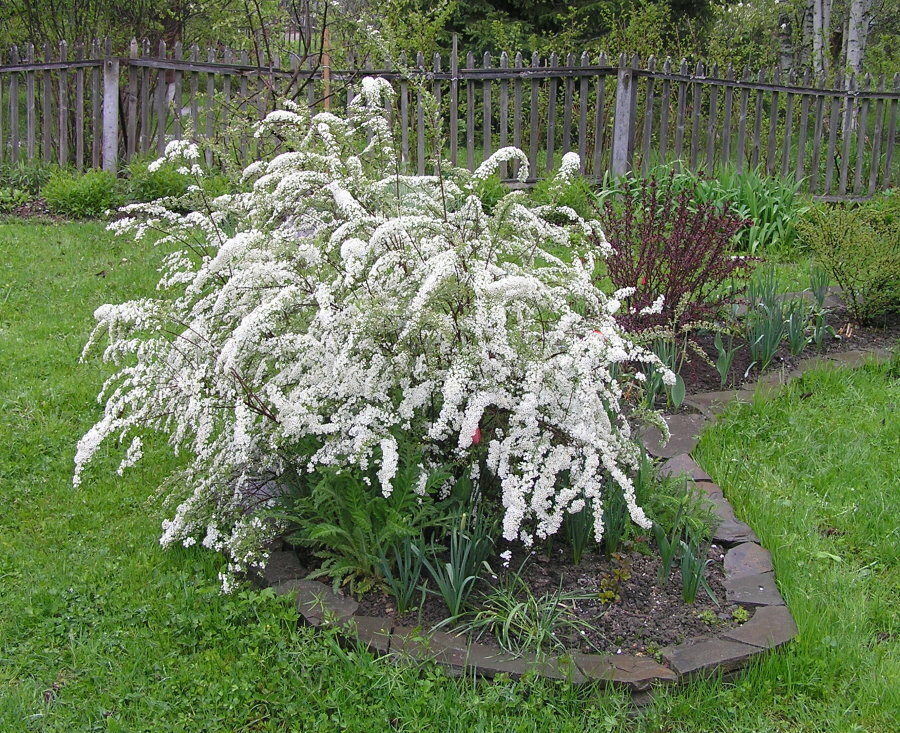
A shrub completely covered with white blooming balls is one of the most attractive varieties of spirea
Reasons for the popularity of spirea in landscape design
Content
- Reasons for the popularity of spirea in landscape design
- Types, varieties of perennial spirea shrub - description with photo
- Spirea Billard (Spiraea x billardii)
- Spirea oak-leaved (Spiraea chamaedryfolia)
- Japanese spirea (Spiraea japonica)
- Spirea willow (Spiraea salicifolia)
- Spirea Douglas (Spiraea douglasii)
- Spirea nippon (Spiraea nipponica)
- Spirea crenate (Spiraea crenata)
- Spirea Wangutta (Spiraea x vanhouttei)
- Spirea Thunberg (Spiraea thunbergii)
- Spirea Golden Princess
- Tips, advice on growing, care
- Photos of examples of beautiful design of a site with spireas
- Conclusion
- Video: Japanese spirea - planting and care
- Photo: Spirea in the garden
Today spirea in landscape design is one of the most popular plants. The advantages of growing a shrub in the garden:
- Great for decorating any style of landscape.
- There are tall (over 2.5 meters) and miniature (15-25 cm) varieties of the plant.
- Suitable for creating "hedges", borders, garden compositions, as a tapeworm, etc.
- It blooms beautifully and magnificently.
- The plant is presented in varieties that bloom in spring or summer - this is an ideal option for an "ever-flowering" garden.
- It is very unpretentious, it is practically not affected by pests.
- This is a great honey plant.
In nature, this plant lives in steppes, deserts, semi-deserts. Shrubs differ in appearance - they are spherical, pyramidal, creeping, erect and others.
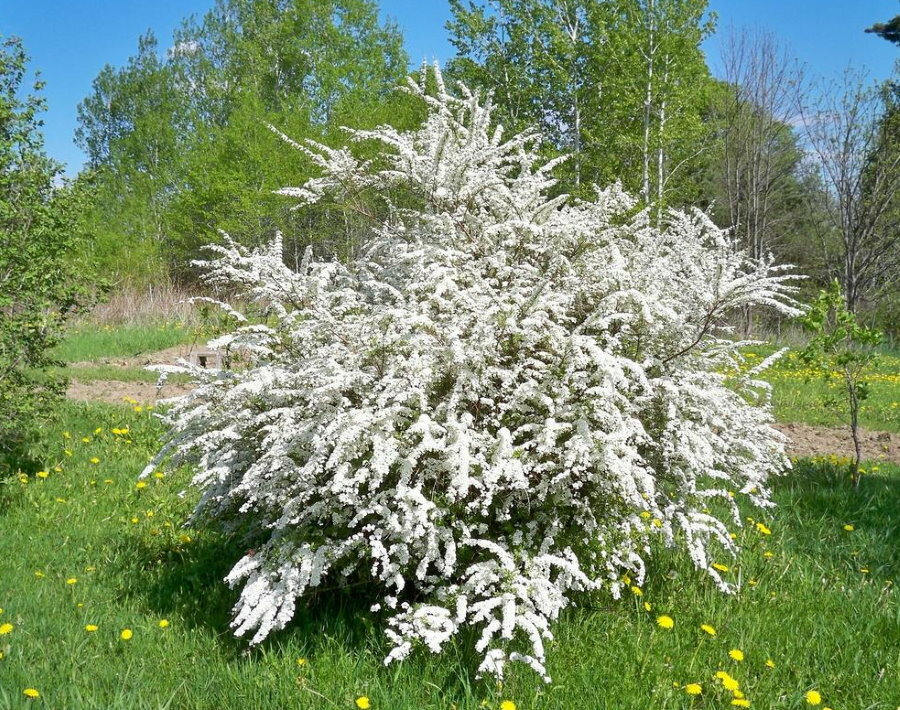
Spirea - many advantages and almost complete absence of disadvantages
Types, varieties of perennial spirea shrub - description with photo
The "live" spirea shrub in the photo is a lush flowering plant. It usually blooms in the third year after planting. Spring-flowering species are recommended to be planted in autumn, summer-flowering species - in autumn or spring.

Low-growing varieties of spirea are great for decorating borders
In the spring, spiraea blooms sharp-toothed, lily, Vangutta, St. John's wort, ash (gray), medium, Nippon, Thunberg. In early to mid-summer, the following types of spirea bloom: Bumalda, dwarf, birch-leaved, Billard, Japanese. In late summer and early autumn bloom Spirea willow, felt, Douglas, white-flowered.
Flowering time may vary by two to three weeks depending on the specific region of planting, weather conditions.
Spirea Billard (Spiraea x billardii)
Billard's spirea is a hybrid plant derived from the Douglas and willow varieties. This is a fairly tall shrub with deviating branches, pyramidal inflorescences, pale pink flowers. This variety is used to create "hedges", usually it is trimmed, giving the desired shape.
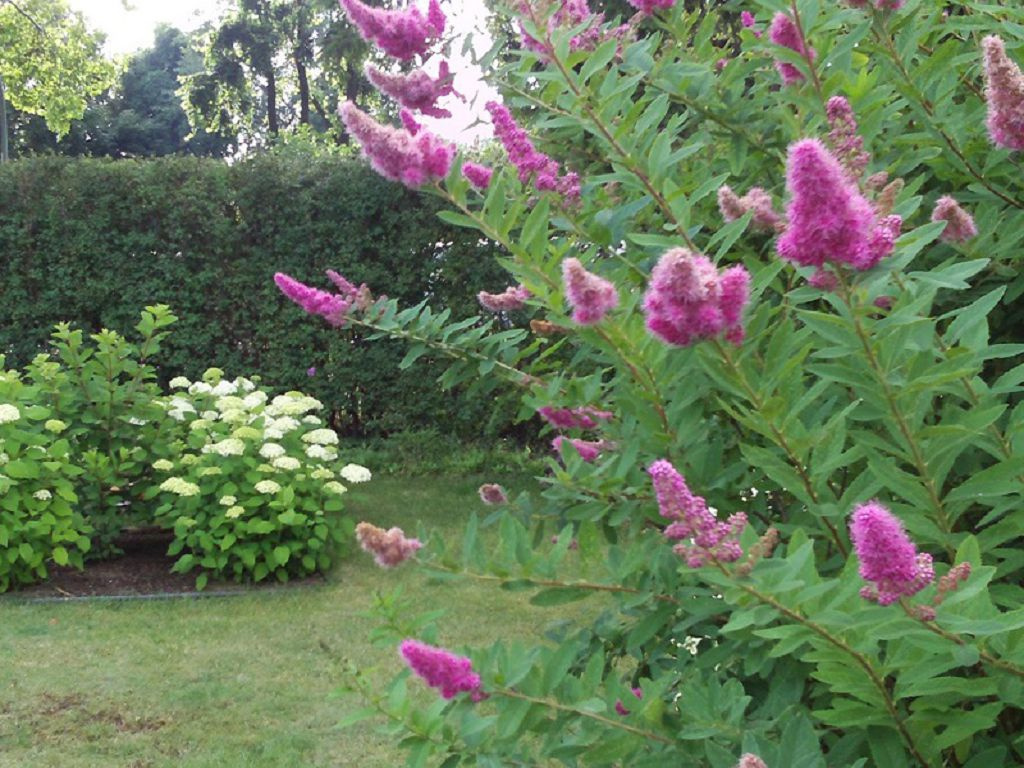
Billard's Spirea is a late flowering variety with a long flowering period
Spirea oak-leaved (Spiraea chamaedryfolia)
Such a plant is highly decorative, has serrated small leaves to the base, snow-white flowers, a rounded dense crown, ribbed shoots. It is planted separately or as part of garden compositions. It grows up to two meters in height, blooms in May, bears fruit in September.
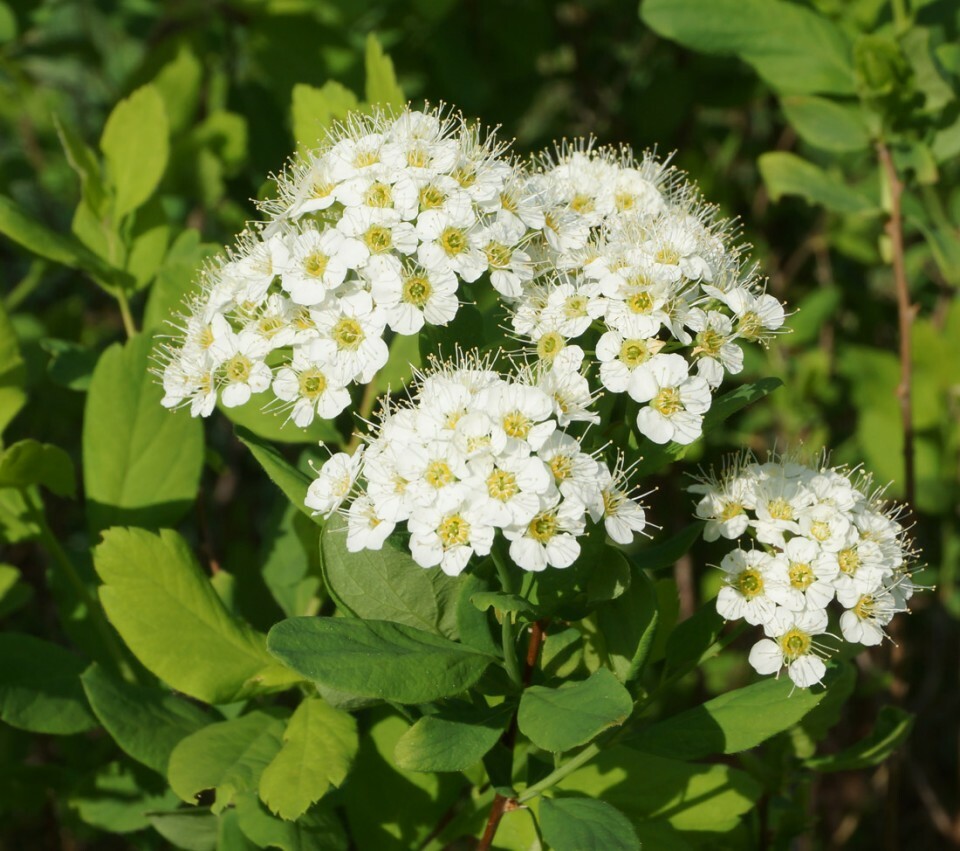
Oak-leaved spirea blooms much earlier than other varieties
Japanese spirea (Spiraea japonica)
The Japanese variety looks like an erect shrub, 120-160 cm high. Leaves are ovoid, with jagged edges, about 10 cm long. The plant blooms from June to August, the most commonly used varieties for garden decoration are "bulat" and "little princesses". In autumn, the foliage turns red, turns yellow, becomes red or crimson - the plant looks beautiful until winter.

A young bush of Japanese spirea at the beginning of the flowering period

With the arrival of autumn, the spirea bush looks completely different.
Spirea willow (Spiraea salicifolia)
The willow spirea grows above two meters. Ten-centimeter leaves are narrow, elongated, inflorescences are pyramidal, consisting of many panicles, about 15 cm long, pinkish or white in color. The shrub blooms from mid-June to mid-late August.
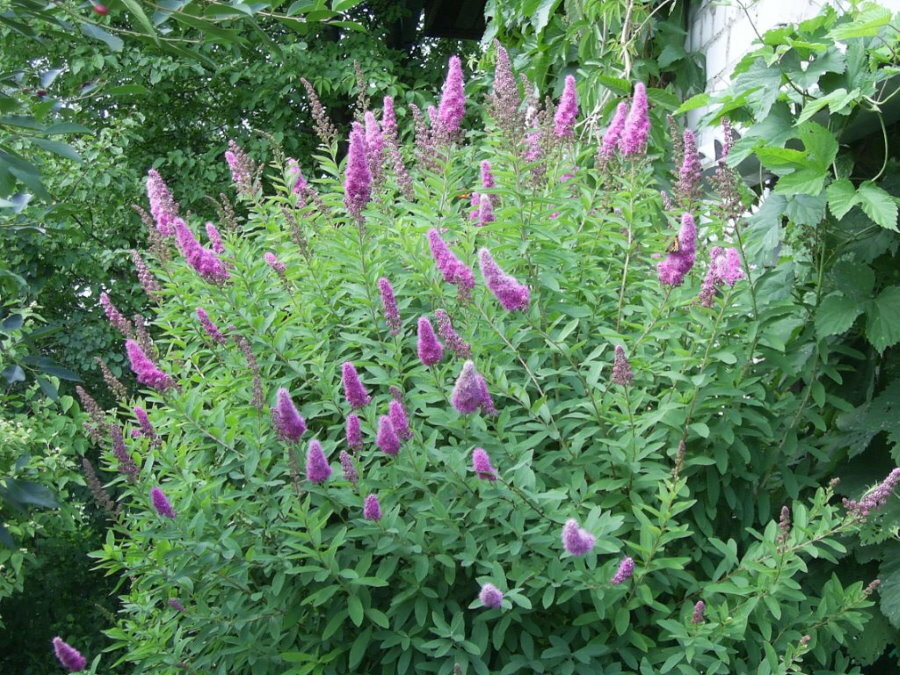
Most types of spirea have curved branches, but willow spirea is not so - its stems are straight
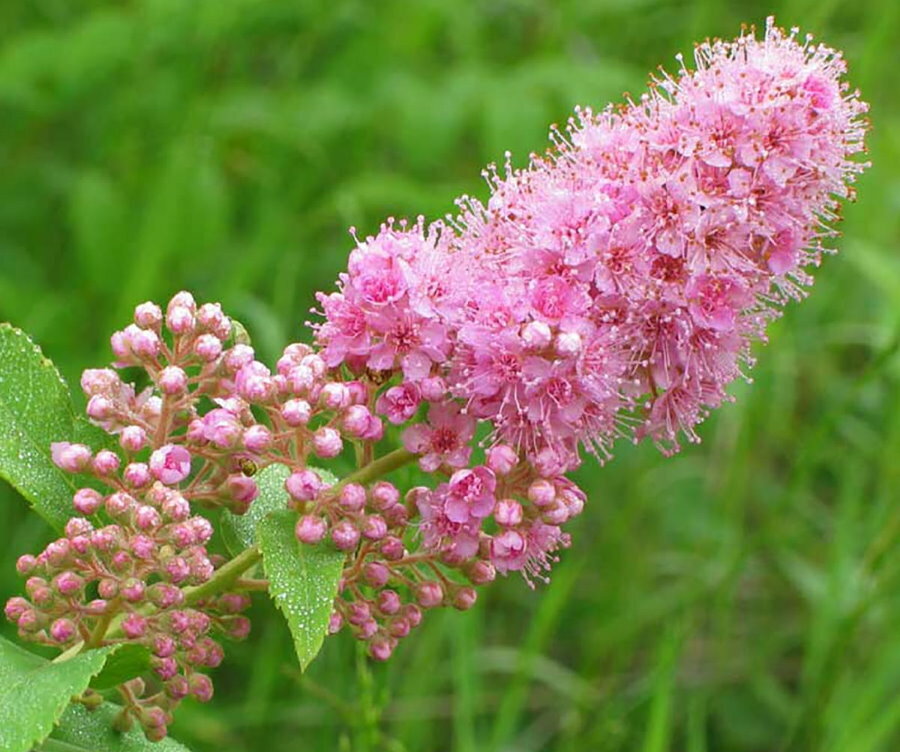
The flowers, although small, but there are a lot of them
Spirea Douglas (Spiraea douglasii)
This species has a height of up to one and a half meters, straight, brown-reddish branches, white-tomentose leaves on the lower side. Blooms in the third decade of June, the inflorescences are directed upwards, painted in deep pink tones, narrow pyramidal shape. In its natural environment, it prefers warm swampy places, begins to bloom from three to four years.

The flowering of this variety of spirea can last up to one and a half months.
Spirea nippon (Spiraea nipponica)
Nippon spirea is distinguished by dark foliage, creamy white flowers, collected in complex inflorescences. The flowering time is from mid-June to August, the leaves remain green until the end of autumn. The branches are directed mainly horizontally, the crown is spherical, compact.

Spirea nippon blooms profusely in open sunny areas
Spirea crenate (Spiraea crenata)
The crenate variety has relatively wide toothed crenate leaves, the inflorescences are located on small leafy lateral branches. The height of the bush is about a meter, the crown is loose, shirokokonicheskaya. Flowers of white-yellow color, flowering lasts 20-25 days. The plant is distinguished by light-requiring, drought resistance, it is used in group plantings to strengthen sandy, rocky slopes.
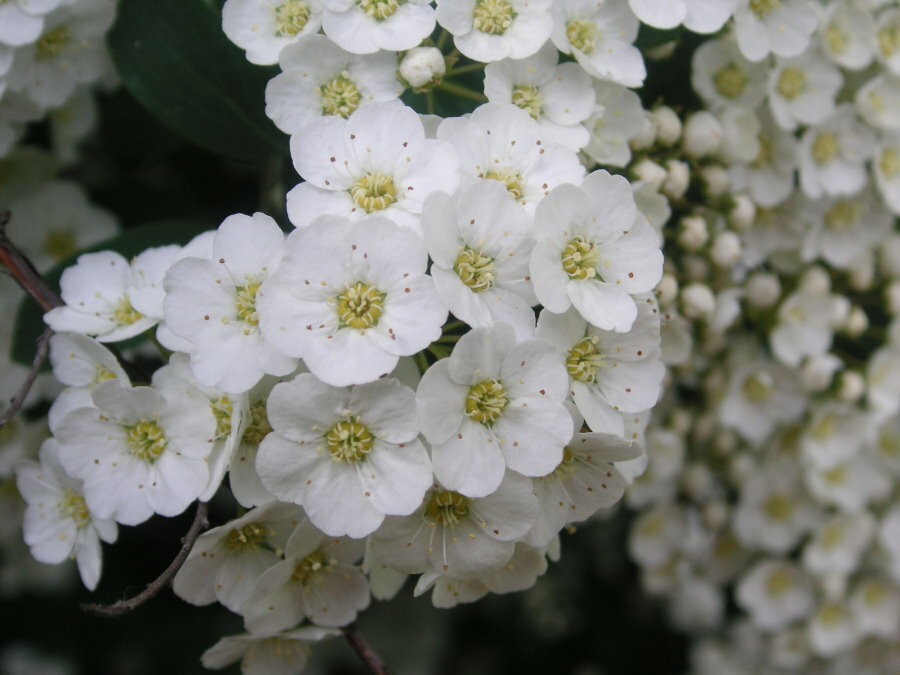
Spirea crenate - a small shrub with a loose crown and beautiful flowers
Spirea Wangutta (Spiraea x vanhouttei)
Such a shrub has dark leaves, snow-white flowers on long arcuate branches that bend to the ground during abundant flowering. The crown is decorative, spreading, up to 180-230 cm in diameter. The leaves themselves are serrated, ovoid, painted dark green on top, light gray on the lower surface. Under favorable conditions, a correctly chosen planting site, the Wangutta spirea blooms twice a year - in spring and at the end of summer.

Spirea Wangutta is equally good both in single plantings and as a hedge
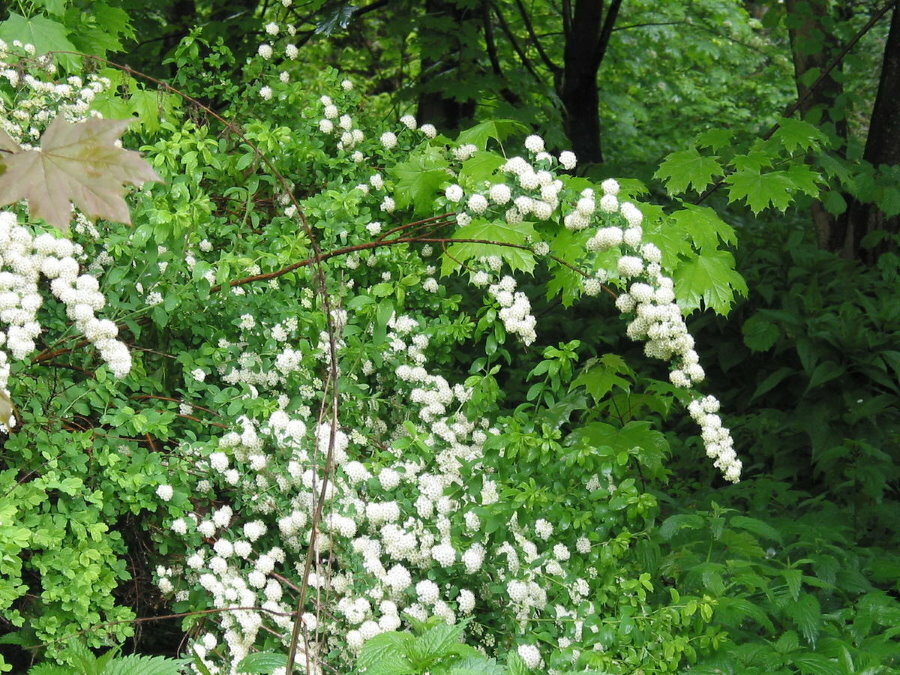
It is surprising that the branches of the spirea are so strong that they do not break even when bent to the ground under the weight of the water after a heavy downpour
Spirea Thunberg (Spiraea thunbergii)
Spirea Thunberg or "snow willow" looks beautiful, but is afraid of frost. She has white small flowers resembling asterisks, lanceolate leaves. Early flowering, dome-shaped crown, height and diameter up to 190 cm, small, brownish fruits. Grows well in partial shade, on wet sandy or loamy soils. It is used for landscaping cities, as it perfectly absorbs dust, tolerates gas pollution in streets.

Spirea Thunberg is a graceful shrub often called snow willow
Spirea Golden Princess
"Golden Princesses" is a dwarf species (up to 50-60 cm) with a dense rounded crown that retains a bright yellow color of foliage all summer long. Often used in urban plantings, blooms in June-July, prefers loose soil where water does not stagnate. The flowers are pink-red, the leaves are pointed, up to seven cm long.
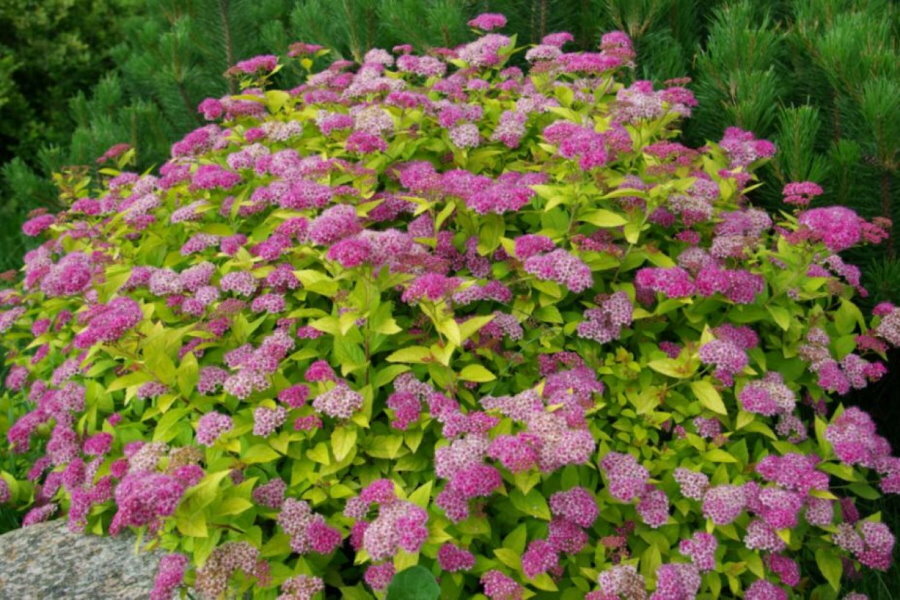
Golden Princess variety is a type of Japanese spirea.
Tips, advice on growing, care
Spirea is planted in the spring (immediately after the snow melts) or in the fall (before the onset of frost). The plant propagates both by cuttings, layering, dividing the bush, and by seeds. When planting as part of hedges or compositions, the distance between bushes and rows is at least 40-50 cm. The average lifespan of a spirea is 20-30 years, depending on the variety.
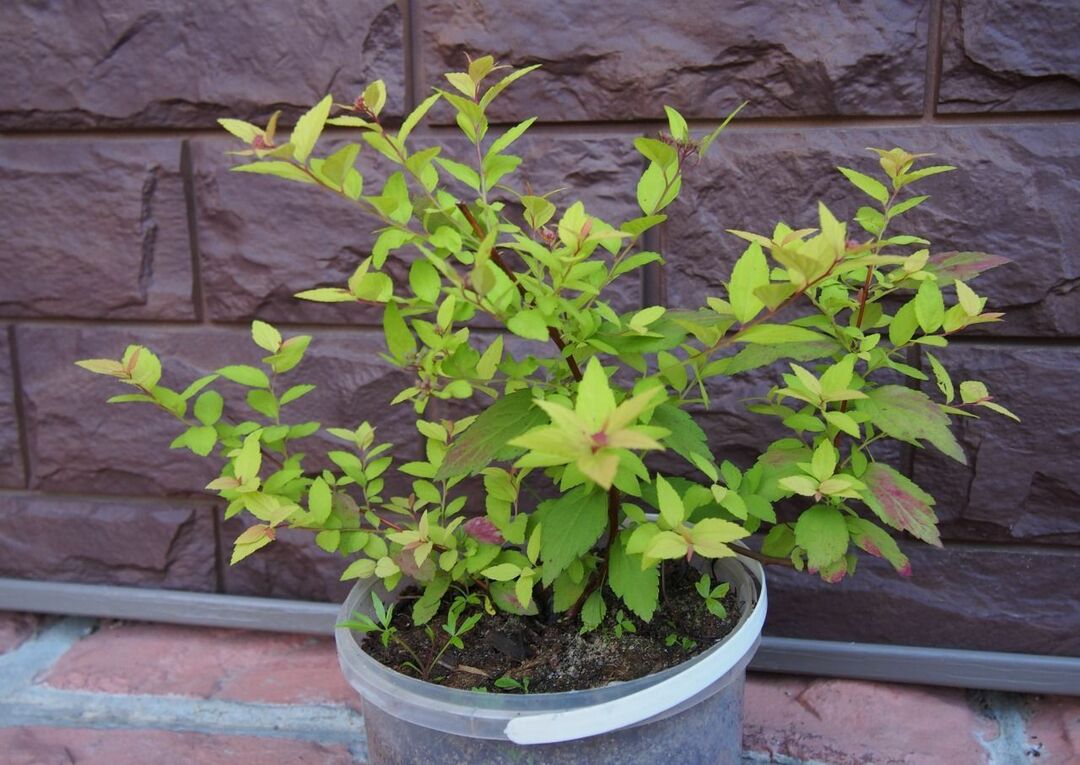
For planting in a summer cottage, it is better to choose a small seedling aged 2-3 years
When planting seedlings, a square hole is dug, measuring 50 by 50 cm. If the soil is dense, heavy, a drainage layer must be made at least 10-15 cm thick, from coarse river sand, pebbles, broken brick. A suitable soil mixture contains one part of peat, one part of sand, two parts of leaf or sod land. Before placing the seedling in the hole, it is recommended to dip the roots in a clay solution. After the roots are carefully covered with prepared earth, compacted, watered with one or two buckets of water.
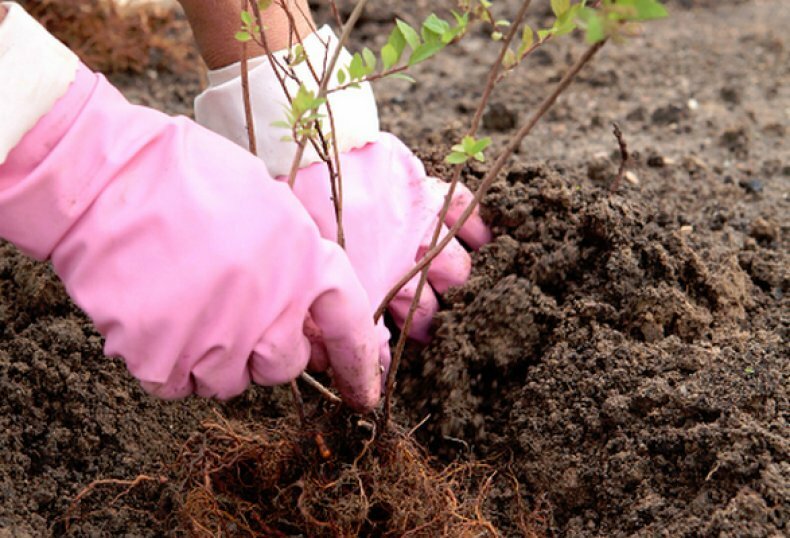
For planting a spirea seedling, it is advisable to choose cloudy weather
Plant care consists in regular, but not excessive watering, weed control, loosening of the earth. Pruning is also used - preventive and decorative. Early-flowering varieties are trimmed immediately after flowering, shortening the shoots by about half. Old (six to seven years old) and weak shoots are removed completely. Summer-flowering varieties are pruned in early spring, removing frostbitten branches broken during the winter, renewing the tops, removing shoots thickening the crown. Young plants (up to four to five years old) are pruned to the first large buds; in older plants, it is permissible to leave 30-centimeter branches.

Spirea is a sufficiently frost-resistant shrub for the middle lane. In colder regions, the plant is sheltered for the winter, constructing a “breathing house” above it from available materials
The shrub is rarely damaged by parasites - the most dangerous are spider mites, leaf rollers, and aphids. To combat them, folk remedies, industrial pesticides are used. To keep the plant healthy, bloom magnificently, fertilizers are applied under it. It is recommended to do this in early spring, complex formulations are preferred. In cold regions, for the winter, the roots of the bush are insulated with fallen leaves and spruce legs.
Photos of examples of beautiful design of a site with spireas
The most striking in landscape design in the photo, the Japanese spirea looks. It includes the long-flowering Darts Red, dwarf Albiflora, blooming white, Bullata with wrinkled leaves, frost-resistant Crisp with a ball-shaped crown, Goldflame with golden leaves. Little princess is also planted often, usually alone. It has brown-red shoots, reddish-pink inflorescences, high winter hardiness. The popular variety is Grafsheim or gray, with drooping branches, snow-white flowers.
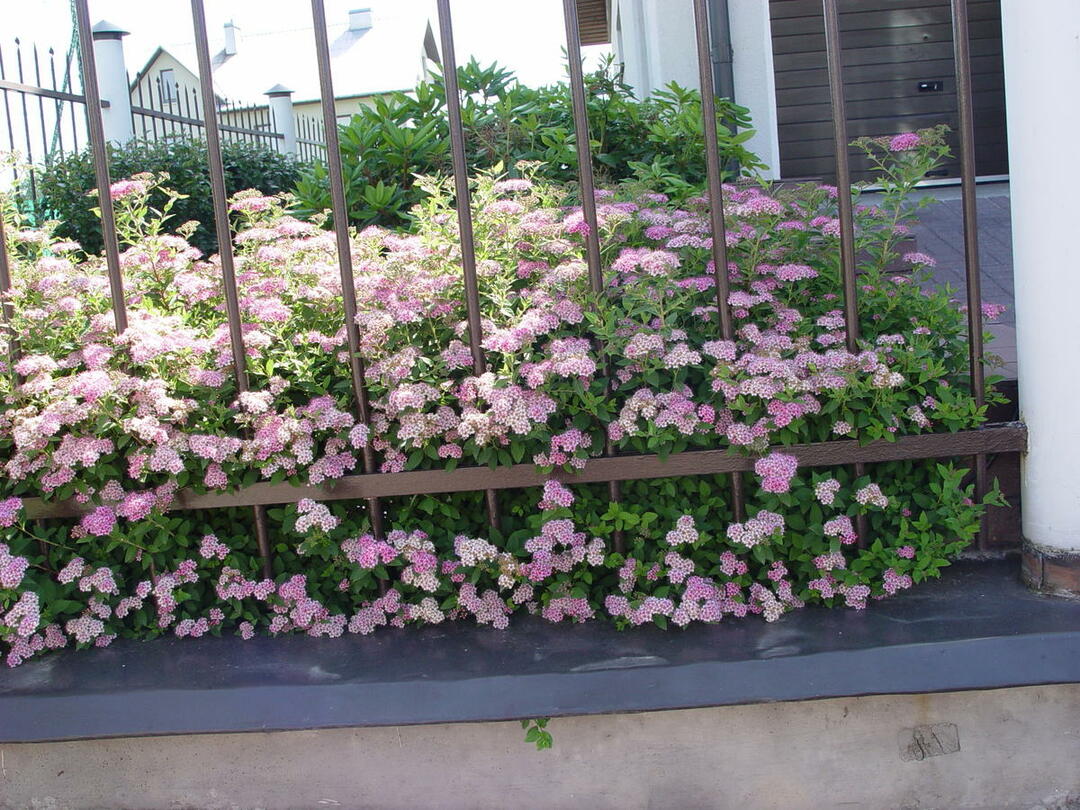
Since spireas are easy to cut, hedges can be created from them.

Live walls can be high or low, depending on the selected variety
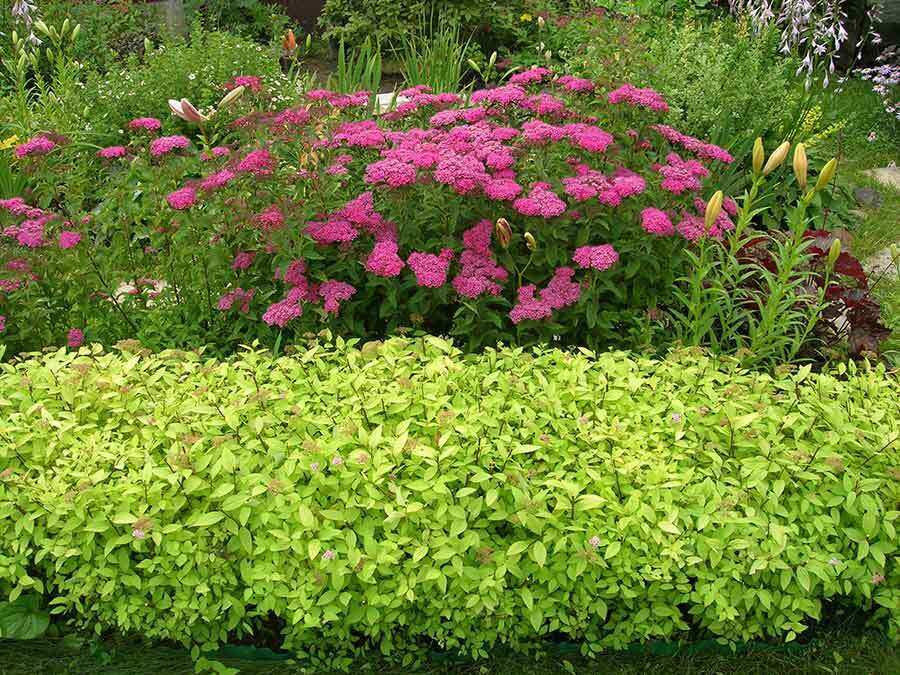
Spireas blend harmoniously with many garden crops

Japanese spirea feels great on a rocky hill
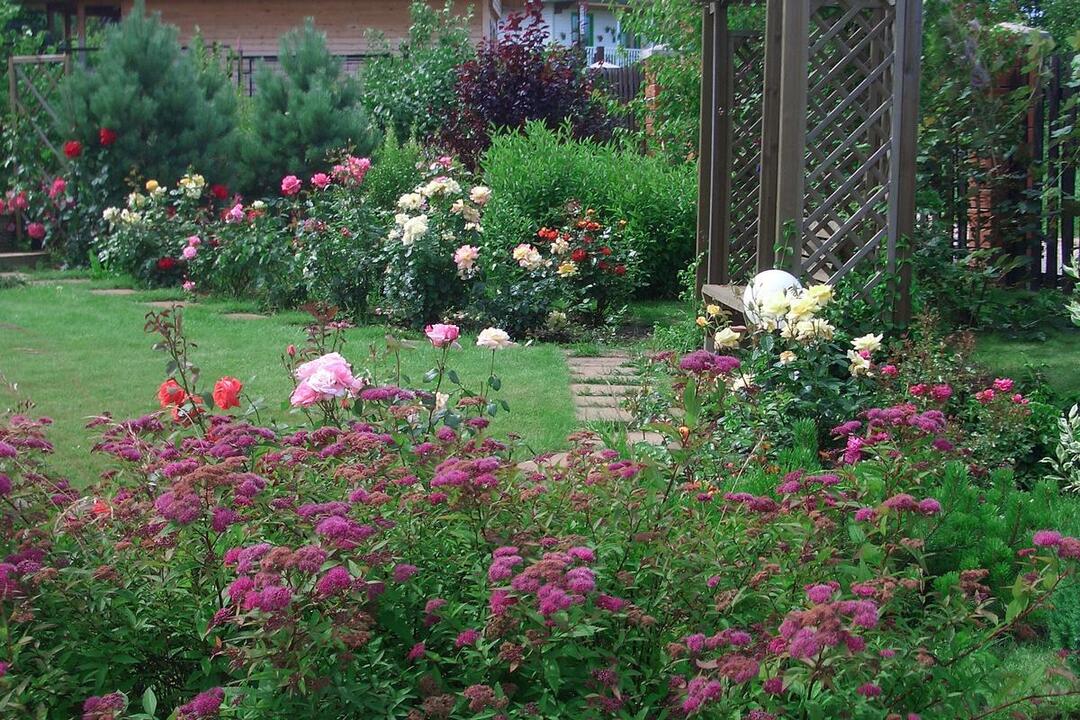
Summer blooming spireas look good with roses
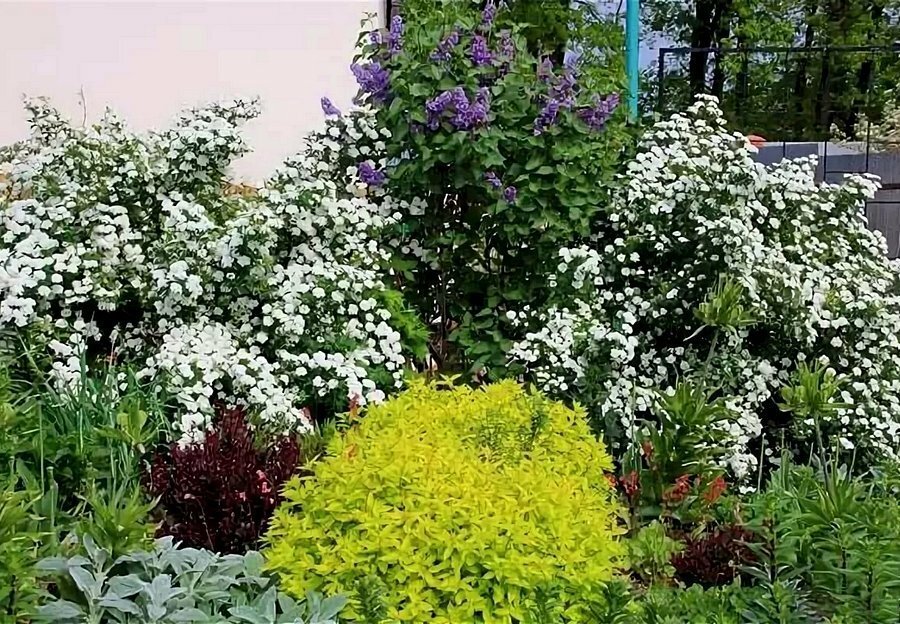
Different types of spirits can be combined with each other to create unique compositions
Spirea plantings are "lace" hedges around the perimeter of the site, multi-colored alpine slides. Instances with arched drooping branches are planted in open areas, from pyramidal ones - they create small alleys. The shrub feels great next to quince, apple, lilac, daffodils, hydrangeas, cornflowers, conifers. Dwarf plants are planted in the form of rabatki, curbs or alpine hills, varieties with a powerful root system form slopes in areas with a slope.
Conclusion
Spirea shrub is able to decorate any garden, give it uniqueness. Several species are often planted on one site at the same time. For successful cultivation, it is recommended that you familiarize yourself with gardening books published under different editions, use the advice of practicing specialists.
Video: Japanese spirea - planting and care
Photo: Spirea in the garden




